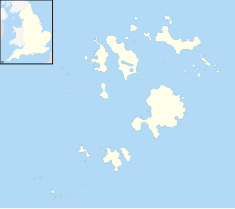|
Isles of Scilly Town Hall
The Isles of Scilly Town Hall is a municipal building in Hugh Town, on the Isles of Scilly, in England. The building, which serves as the offices of Council of the Isles of Scilly, is a Grade II listed building.[1] HistoryThe building was commissioned by Algernon Dorrien-Smith, whose uncle, Augustus Smith had acquired a lease over the Isles of Scilly from the Duchy of Cornwall for £20,000 in 1834, and created himself Lord Proprietor of the Isles of Scilly.[2] He had intended that it would accommodate a market hall and some public rooms.[3] The site he selected was an area known as The Parade, a small park situated at the centre of the isthmus, which had served as a parade ground for the Sea Fencibles during the Napoleonic Wars.[4] The new building was designed by J. Goodfellow in the neoclassical style, built in coursed granite and was completed in 1889.[1] It served as a public hall, theatre, magistrates' court, council chamber, and local authority offices.[5] In 1891, the Isles of Scilly Rural District Council was formed, as a sui generis local government authority, outside the administrative county of Cornwall.[6] The council established its offices in the town hall,[7] and went on to commission an extension to create extra office space in 1970.[8] Following the implementation of the Local Government Act 1972, the council was renamed as the Council of the Isles of Scilly.[9][10] The council relocated its council chamber to the Old Wesleyan Chapel on Garrison Lane, in 2002.[11][12] By the 2010s, the town hall was in poor repair and the stage area was condemned in 2017. In 2024, the council received a £4.6 million National Lottery Heritage Fund grant to restore the building.[13] The building will house a cultural centre and the Isles of Scilly Museum, whose previous building, purpose-built in 1967, was condemned as unsafe in 2019.[14] Some of the existing museum's objects were moved into temporary storage in the town hall in 2020.[15] ArchitectureThe two-storey building is constructed of squared and coursed granite, and it has a slate roof. It has a rectangular plan. The design involves a symmetrical main frontage of three bays facing onto The Parade. The central bay features a doorway flanked by two sash windows. The first floor is fenestrated by three more sash windows and all openings have segmental surrounds and keystones. At roof level there is a pediment. with a date stone flanked by two small windows in the tympanum. The building was grade II listed in 1992.[1] References
External links |
||||||||||||||||||||||||||
Portal di Ensiklopedia Dunia

